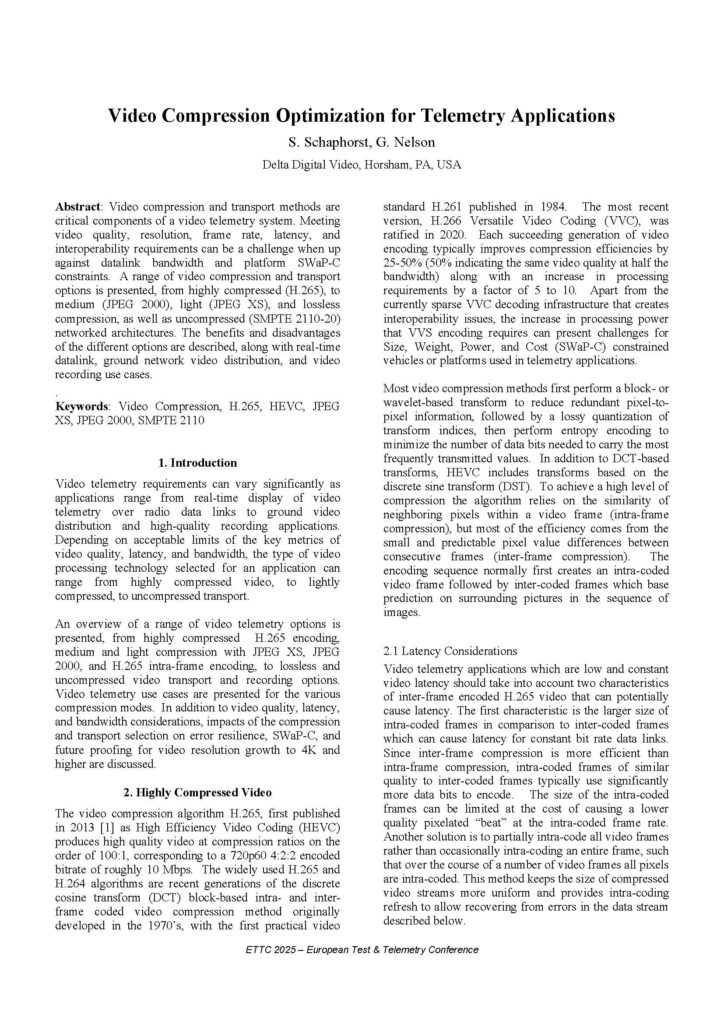
In modern telemetry environments, video has become just as critical as data. Whether capturing real-time cockpit footage, monitoring missile launches, or recording space-based operations, the ability to transmit, store, and replay high-quality video, without overwhelming bandwidth or increasing latency, is essential.
Delta Digital Video’s latest white paper, Video Compression Optimization for Telemetry Applications, by Steve Schaphorst and George Nelson, explores the technical tradeoffs and mission-driven use cases behind various compression methods, helping engineers select the best option for their system requirements.
Understanding the Tradeoffs
The challenge in telemetry video compression lies in balancing five key factors:
- Video quality
- Frame rate
- Latency
- Bandwidth consumption
- SWaP-C (Size, Weight, Power, and Cost) constraints
Compression formats differ in how they prioritize these factors. For example, H.265 (HEVC) offers high compression ratios but introduces latency that may not be acceptable for real-time applications. JPEG XS, on the other hand, is visually lossless and ultra-low latency but requires more bandwidth.
Key Compression Formats Explained
The paper provides a detailed comparison of the following video encoding options used in telemetry:
- H.265 (HEVC):
Ideal for bandwidth-constrained links with less stringent latency requirements. Offers excellent compression efficiency, widely used for archival and non-real-time monitoring. - JPEG 2000:
Offers visually lossless quality with manageable latency. Suitable for situations where fidelity and error resilience matter more than real-time interaction. - JPEG XS:
Optimized for low-latency, high-fidelity video. Perfect for applications that require “glass-to-glass” responsiveness, like cockpit view telemetry or live weapon system tracking. - Uncompressed (e.g., SMPTE 2110-20):
Offers the best possible video quality but demands extremely high bandwidth. Suitable only for short-range, high-capacity links or post-mission playback.
Real-World Telemetry Applications
Each video compression method has strengths tied to specific mission needs:
- H.265: Long-range UAV video feeds
- JPEG 2000: Ground-based distribution networks
- JPEG XS: Live airborne telemetry and weapon testing
- Uncompressed: Video analysis labs or post-flight investigations
The paper also explores the importance of interoperability across telemetry ground stations, airborne systems, and networked video infrastructures.
Choosing the Right Format for Your Mission
No single compression format works for every telemetry scenario. The paper recommends that system designers consider:
- Link characteristics (bandwidth availability and distance)
- Latency tolerance
- Compression-induced video degradation
- Ground system compatibility
- Storage requirements
Delta Digital Video offers a suite of encoding and decoding products that support multiple compression formats, including H.264, H.265, JPEG 2000, and JPEG XS, allowing users to tailor solutions for their mission’s unique needs.
Interested in optimizing your video telemetry solution?
📄 Download the full white paper or contact Delta Digital Video for guidance on selecting the right compression strategy.
